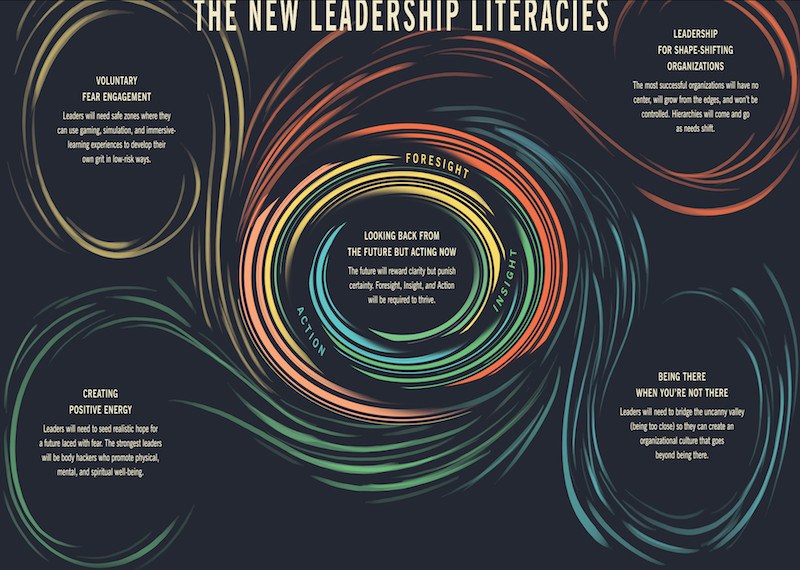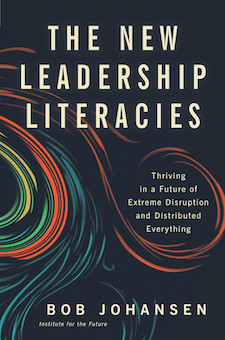 In this 25-minute podcast interview, I had the pleasure of talking with futurist Bob Johansen, Distinguished Fellow of the Institute for the Future about leadership of the future.
In this 25-minute podcast interview, I had the pleasure of talking with futurist Bob Johansen, Distinguished Fellow of the Institute for the Future about leadership of the future.
We discussed the forces most likely to disrupt organizations and what will be required of leadership – topics he addresses in his fascinating new book The New Leadership Literacies: Thriving in a Future of Extreme Disruption and Distributed Everything.
Here are some of the questions we explored during our conversation:
What exactly is a futurist?
In your book you say, “The way to evaluate a futurist is to ask if the foresight provoked an insight that led to a better decision in the present. The way to evaluate a fortune teller is to ask whether or not the foresight actually happened. Futurists should not and cannot predict the future. Instead, futurists should provoke insight.”
Why will the future be increasingly disruptive and distributed?
It looks like the major shift you are talking about is from centralized control to distributed networks. What do you mean by distributed networks? Why are they so valuable and powerful? Is this change inevitable or do leaders have a choice?
What will organizations of the future look like?
You use metaphors like fishnets and shape-shifting to describe organizations of the future – organizations that have no center, grow from the edges, and cannot be controlled. Can you give some examples of organizations that are like that now? You say that the organizations that have best adapted to and utilized this disruptive force are the military, terrorists and criminals. Why is that?
In your book you say, “Hierarchical practices for centralized organizations will be brittle in a future that is not only decentralized, but distributed.” Why will they be decentralized and why won’t hierarchical practices work?
What will successful leadership of the future look like?
You say that leaders of the future will need to have “clarity but not certainty.” What do you mean by this? What’s the implication for how leaders act?
You talk about distributed authority. Why will authority be distributed and what’s the implication for leadership?
You also talk about the importance of memes as a vehicle of communication. Can you tell us what they are and how they are useful for the leadership of the future?
Click below to listen to our interview.
I hope you enjoy listening to Bob’s responses as much as I did.
About The New Leadership Literacies by Bob Johansen
 Over the next decade, today’s connected world will be explosively more connected. Anything that can be distributed will be distributed: workforces, organizations, supply webs, and more. The practices of centralized organizations will become brittle in a future where authority is radically decentralized. Rigid hierarchies will give way to liquid structures. It’s too late to catch up, but it’s a great time to leapfrog. Noted futurist Bob Johansen shows how to forecast likely futures, how to use gaming to address the future and hone your leadership skills, how to lead shape-shifting organizations, and how to be a dynamic presence even when you’re not there in person. A must-read for anyone who wants to have influence in an organization, today and in the future. The New Leadership Literacies is available at Amazon, Berrett-Koehler, and IndieBound.
Over the next decade, today’s connected world will be explosively more connected. Anything that can be distributed will be distributed: workforces, organizations, supply webs, and more. The practices of centralized organizations will become brittle in a future where authority is radically decentralized. Rigid hierarchies will give way to liquid structures. It’s too late to catch up, but it’s a great time to leapfrog. Noted futurist Bob Johansen shows how to forecast likely futures, how to use gaming to address the future and hone your leadership skills, how to lead shape-shifting organizations, and how to be a dynamic presence even when you’re not there in person. A must-read for anyone who wants to have influence in an organization, today and in the future. The New Leadership Literacies is available at Amazon, Berrett-Koehler, and IndieBound.













Jesse, this was a wonderful interview. Bob’s ideas are insightful and seem to be “right on” for the future. It gives me many things to think about and lean into. Thanks
I was especially intrigued by his comments that he’s less concerned about the current populism than of the unboundedness the future is moving toward. But as he says, he thinks more in terms of decades than years.